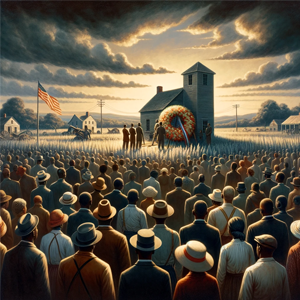 On April 13, 1873, an event occurred in Grant Parish, Louisiana, that would mark one of the darkest days in the history of post-Civil War America: the Colfax Massacre. This event did not happen in isolation; it was the culmination of intense political and racial tensions that had been brewing in the South. To understand the significance of the Colfax Massacre, it’s essential to delve into the political climate of the time, the enforcement of the 15th Amendment, and the events leading up to, during, and after the massacre.
On April 13, 1873, an event occurred in Grant Parish, Louisiana, that would mark one of the darkest days in the history of post-Civil War America: the Colfax Massacre. This event did not happen in isolation; it was the culmination of intense political and racial tensions that had been brewing in the South. To understand the significance of the Colfax Massacre, it’s essential to delve into the political climate of the time, the enforcement of the 15th Amendment, and the events leading up to, during, and after the massacre.
In the years following the Civil War, the Southern states, including Louisiana, were undergoing significant political and social transformations. The Reconstruction era was marked by attempts to rebuild and reintegrate the South into the Union, which included ensuring rights for the newly freed African American population. Grant Parish, named after President Ulysses S. Grant, was created in 1869 from parts of Winn and Rapides Parishes. This new parish became a focal point for the political tensions of the era, especially around the enforcement of the newly ratified 15th Amendment, which prohibited voting discrimination based on race, color, or previous condition of servitude.
The Grant administration was determined to enforce the 15th Amendment, especially against groups like the Ku Klux Klan, which sought to intimidate and suppress black voters through violence. In response to the widespread violence and to help reduce tensions in Grant Parish, William Ward, a black militia leader, was appointed. His presence and actions, however, would further inflame the situation, leading to increased hostilities between the black militia and white supremacist groups.
The election of 1872 in Louisiana was highly contested, leading to disputes over who had won: the Republican incumbent, William Pitt Kellogg, or the Democrat John McEnery. The election’s aftermath saw the state divided, with two governments claiming legitimacy. It was within this context of political chaos that Grant Parish was created, and it quickly became a symbolic battleground for these broader conflicts.
Tensions in Grant Parish escalated into direct conflict at the Colfax Courthouse, where a standoff occurred between the predominantly black Republican militia, who had taken control of the courthouse, and white supremacist groups, including former Confederate soldiers and members of the White League, who sought to reclaim it for the Democrats. This confrontation was about more than just control of a building; it was a fight over political power and racial dominance.
The white supremacist groups viewed the standoff as an affront to their efforts to regain control of Louisiana’s political system and to reassert white dominance. Their reaction was fueled by deep-seated racism and a desire to reverse the gains made by African Americans during Reconstruction.
The Colfax Massacre unfolded as the white supremacist groups attacked the courthouse, resulting in the death of over 100 African Americans, many of whom were murdered after they had surrendered. This brutal event is considered one of the worst instances of racial violence during the Reconstruction era.
The aftermath of the Colfax Massacre was grim. Few white perpetrators were held accountable for their actions, and the incident signaled a turning point in the Reconstruction era, emboldening white supremacist groups and contributing to the federal government’s diminishing efforts to protect African American rights in the South.
The Grant administration’s reaction to the Colfax Massacre was seen by many as inadequate. While there were some attempts to prosecute the perpetrators, the efforts were largely unsuccessful, and the administration faced criticism for its failure to protect the rights of African Americans more forcefully.
The Colfax Massacre’s legacy is a somber reminder of the challenges of rebuilding the nation in the aftermath of the Civil War and the deep-seated racial animosities that persisted. It also highlights the limitations of the Reconstruction era in achieving its goals of racial equality and justice.
The Colfax Massacre, like many other acts of racial violence during Reconstruction, has been overshadowed in the national memory by other historical events. The reluctance to confront the uncomfortable truths of America’s racial history and the complex nature of Reconstruction have contributed to its relative obscurity. Moreover, the narrative of Reconstruction has often been shaped by those who sought to downplay the violence and racism of the era, further marginalizing events like the Colfax Massacre.
The Colfax Massacre stands as a stark testament to the tumultuous period of Reconstruction and the struggle for racial equality in the United States. Understanding this event and its implications is essential for grappling
Leave a comment